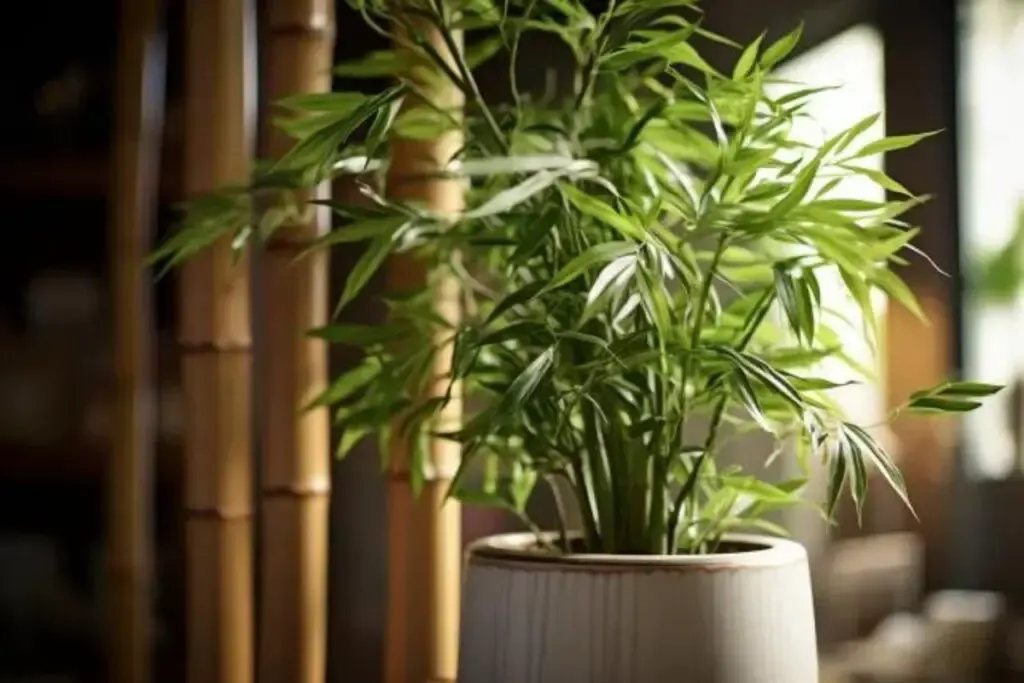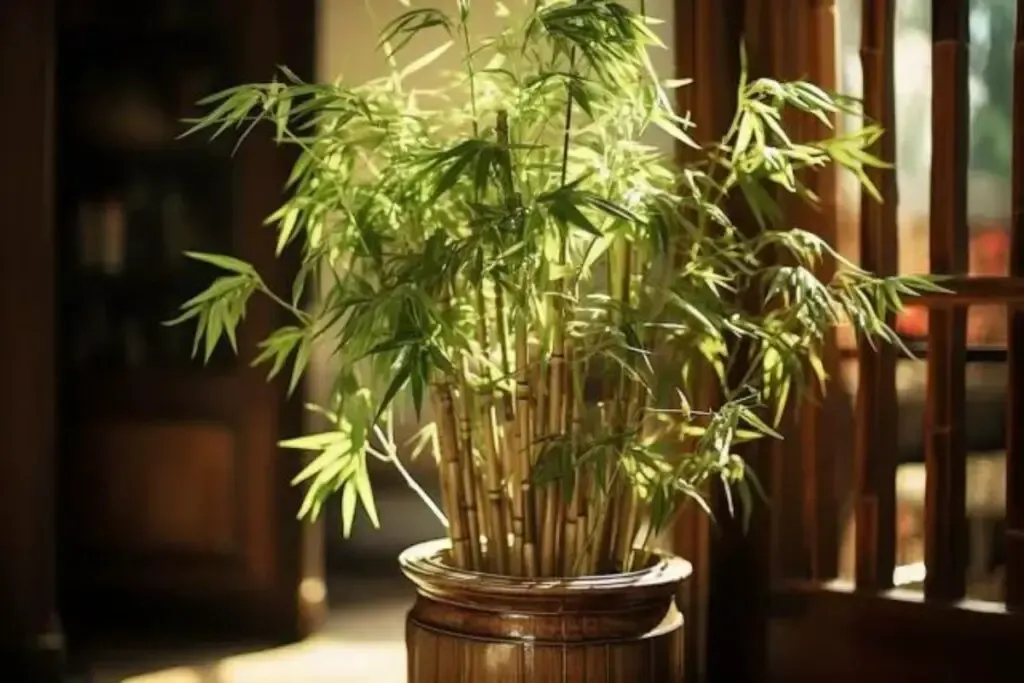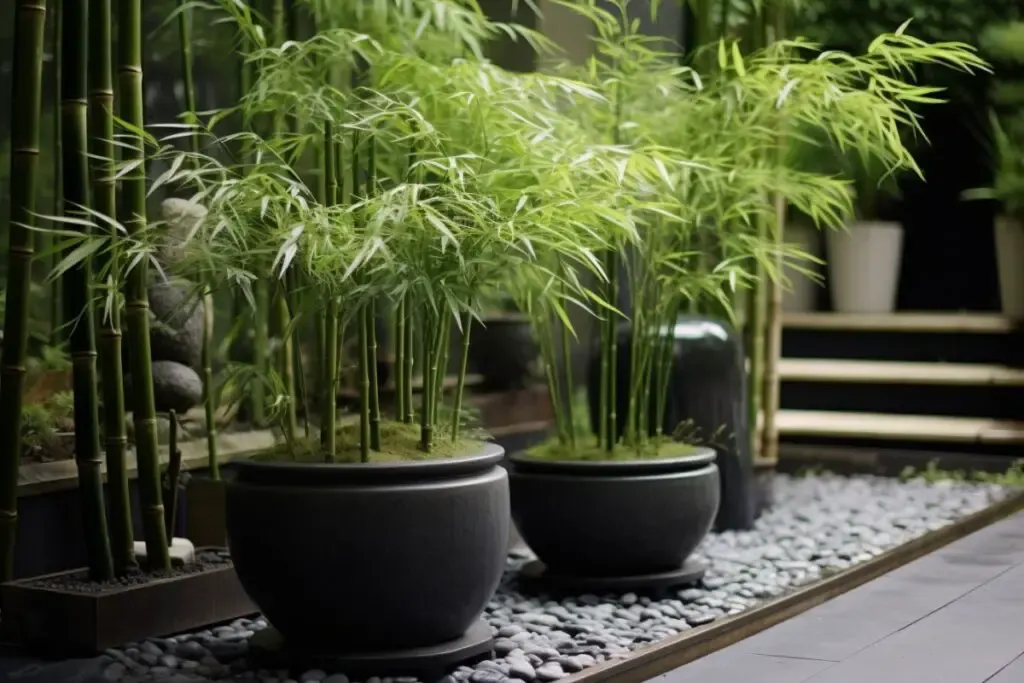Growing bamboo in pots isn’t just a horticultural statement—it’s a stylish nod to minimalist design and a testament to versatility in gardening.
Whether you’re working with a balcony, a patio, or just a sunny corner in your home begging for some greenery, bamboo can be your go-to plant. It’s resilient, it grows fast, and it brings an instant feel of zen.
But how does one morph from a bamboo novice to a veritable pot-cultivating maestro? Well, my friends, that’s precisely what I’m here to divulge.
Does Bamboo Grow Well in Pots?
The short answer is a resounding yes! Bamboo can thrive in pots, and quite elegantly so. Think of pots as mini-ecosystems; with the right conditions, they can support the unique requirements of these grassy giants.
The keys to success are choosing the right variety (we’ll get into that shortly), understanding the bamboo’s needs, and then meeting them consistently—think proper soil, adequate watering, and the right pot size.
It’s all about balance. Too little space, and your bamboo roots will be gasping for room. Too much water and you might as well be setting sail on a soggy journey to root rot.
But get it right, and you’ll witness a magnificent spectacle of upright growth and perhaps even the whimsical sway of leaves in the gentle breeze.
Best Bamboo Varieties for Pots
Now, not all bamboo is born equal—especially when it comes to potted life. Some varieties are simply better suited to the container lifestyle. They’re the ones that won’t grow too large, too fast, and have a more compliant nature.
So, let’s introduce you to some prime candidates for your potting pleasure.
1. Fargesia Robusta ‘Pingwu’

Fargesia robusta ‘Pingwu’, often revered as the ‘Green Screen’, is a clumping bamboo that plays by the rules in the pot world. It doesn’t spread aggressively and instead grows in a tidy, upright manner.
This variety can reach heights of up to 15 feet, which in the bamboo universe, is quite manageable. It’s a privacy screen champion and is well-loved for its resilience against cold snaps.
Give ‘Pingwu’ a spot with ample sunlight, and it will return the favor with lush, vibrant growth.
2. Bambusa multiplex ‘Alphonse Karr’

Bambusa multiplex ‘Alphonse Karr’ is your go-to if you want to make a statement with stripes. This bamboo features stunning canes striped with hues of yellow and green, giving it a unique appearance.
It’s a clumper, which means it won’t take over your space unexpectedly. ‘Alphonse Karr’ prefers the sun but will tolerate some shade, and it’s relatively drought-tolerant once established. Its manageable size and ornamental beauty make it a favorite for container gardening.
3. Pleioblastus shibuyanus ‘Tsuboi’

Venturing into the dwarf varieties, Pleioblastus shibuyanus ‘Tsuboi’ is a delightful little bamboo that’s perfect for pots due to its small stature. It’s an excellent option if you’re limited on space or simply prefer something that’s a bit more low-maintenance.
This bamboo provides a lush, dense growth that can be pruned to form a neat, decorative shape. ‘Tsuboi’ is quite the charmer with its variegated leaves, adding texture and color to your potted plant collection.
Each bamboo variety brings its own personality to the table—or should I say, to the pot. While they’re different, they share the traits that make them excellent choices for container living: manageability, beauty, and a harmonious existence with their potted confines.
Keep them happy with the right soil, the correct size pot, and a consistent watering schedule, and you’ll have a thriving bamboo oasis that even the most seasoned gardeners will admire.
How to Grow and Care For Bamboo in Pots
Cultivating bamboo in pots is an art form akin to the ancient practices of bonsai—though, thankfully, with a bit less complexity. It’s about creating the right environment for these stately grasses to flourish.
Let’s break down the essentials of potting and pampering your bamboo so that it grows up healthy, happy, and robust.
Planting
Planting bamboo is a straight shot from mundane to magical. Begin with a healthy plant from a reputable nursery. When planting, ensure the root ball is level with the soil surface—no deeper, no shallower.
This helps the plant adjust to its new home without stress. Position the bamboo in the center of the pot, spread the roots gently, and fill in with soil, tamping down lightly as you go to eliminate air pockets.
Pot Size
Bamboo in pots is a bit like Goldilocks—not too big, not too small, just right. The pot should be large enough to accommodate the root mass with room to grow, typically starting with a pot that’s 18 to 24 inches in diameter.
Remember, bamboo can be a vigorous grower, so plan to upsize the pot every few years to prevent it from becoming root-bound.
Light
Sunlight is to bamboo what applause is to performers—absolutely vital. Most bamboos revel in full sun to partial shade. If you notice the leaves curling, that’s bamboo’s way of saying it’s a tad too bright.
Find a sweet spot where your potted bamboo can bask in the morning light but is shielded during the harshest afternoon rays.
Soil
Bamboo isn’t picky, but it demands well-draining soil. Opt for a good-quality potting mix that’s rich in organic matter. It should retain moisture yet drain quickly enough to prevent waterlogging.
The pH should ideally hover around neutral, although bamboo is quite adaptable if it swings slightly acidic or alkaline.
Water
The watering ritual for bamboo is less ritual and more practical. Bamboo likes moisture but detests soggy feet. Ensure a regular watering schedule that keeps the soil evenly moist but not drenched.
In the heat of summer, your bamboo may need more frequent watering, while in cooler months, it’s less thirsty.
Temperature and Humidity
Bamboo is rather hardy, but if you’re growing it in a pot, you have the luxury of moving it to suit its temperature preferences. Most varieties enjoy the same conditions we do—moderate temperatures and moderate humidity.
If the mercury plummets, consider moving your potted friend to a protected area. If you’re in a particularly hot zone, a spot with afternoon shade will help keep your bamboo from frying.
Fertilizer
Finally, think of fertilizer as the secret sauce for your bamboo. A balanced, slow-release fertilizer in the spring will kick-start the growing season. Follow up with a gentle feed every few months.
If your bamboo is indoors, be mindful of over-fertilizing; it can do more harm than good, especially in the non-growing season.
Pruning Potted Bamboo
Pruning bamboo in pots is like giving it a tailored suit—it’s all about creating the most appealing shape and encouraging healthy growth. Start by removing any dead or yellowing stalks, using clean, sharp shears. This isn’t just for aesthetics; it helps prevent the spread of disease.
Focus next on thinning out the clump. Bamboo can become dense, and air circulation is vital to its health. Prune selectively, always cutting just above a node, to shape your bamboo and promote new growth. Remember, less is more—you can always trim more later, but you can’t put a culm (bamboo stalk) back once it’s cut.
As you prune, consider the natural form of the bamboo. Aim to maintain its elegant, upright stature. This practice isn’t just maintenance; it’s a conversation between you and the plant. Listen to how it grows and respond with your pruning accordingly.
Overwintering
For all its hardiness, bamboo can be sensitive to the cold, especially when its roots are confined to a pot. Overwintering potted bamboo isn’t complex, but it does require some planning.
Firstly, water your bamboo well before the onset of winter. This pre-winter drink is crucial as it helps the roots retain moisture during the cold months. As temperatures drop, reduce watering significantly but don’t let the bamboo dry out completely.
If your region experiences mild winters, your bamboo may be happy with just a little extra mulch on the soil surface to insulate the roots. However, in areas where the freeze sets in, you’ll want to move your pots to a sheltered spot. This could be against the house, on a porch, or even inside a garage where it remains cold but not freezing.
For those in particularly harsh climates, wrapping the pot in burlap or bubble wrap can provide an additional layer of warmth. Just remember to remove the wrap come spring, and reintroduce your bamboo to the outdoors gradually to prevent shock.
Overwintering is essentially about protecting the roots and preserving the evergreen foliage that many bamboo varieties boast.
With the right care, your bamboo will emerge from its winter respite ready for a season of vigorous growth.

